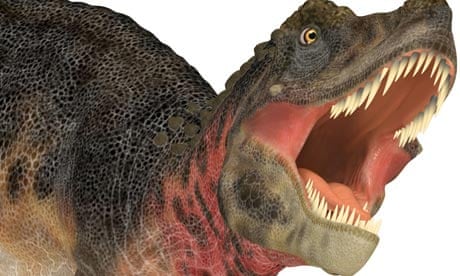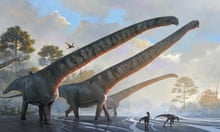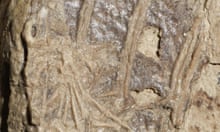Fossils are priceless. I mean that in both senses: they are invaluable clues about vanished lives and their worth should never be measured in dollars. But Eric Prokopi made quite a bit of money dealing fossils and, as it turns out, brazenly smuggling them. He pleaded guilty in December 2012 to conspiracy, making false statements to customs officials, illegally importing fossils into the United States and fraudulent transfer of dinosaur bones. He is due to be sentenced in April and faces up to 17 years in prison. Prokopi's string of offences was finally exposed because of a dinosaur that was almost sold for $1m. His story is one of the most egregious cases of dinosaur rustling in recent years and it shows just how corrupt and harmful to science the fossil market can be.
The ugly tale began when Texas-based Heritage Auctions put out a catalogue for an event in New York City on 20 May last year. The lots included an ankylosaur skull, a troodontid skeleton and the hyped star of the sale, a "75% complete" Tarbosaurus bataar skeleton. This tyrannosaur, which roamed Mongolia about 70 million years ago, was comparable in size and ferocity to its famous cousin Tyrannosaurus rex. (The auction ads took advantage of a taxonomic disagreement among palaeontologists and called the fossil Tyrannosaurus bataar, but I'm in the camp that believes these dinosaurs should be kept in distinct genera.)
It seemed the dinosaur was going to slip away into a private collection. For years, palaeontologists have watched as significant specimens have gone from field sites to wealthy fossil enthusiasts. Some researchers have even had dinosaurs stolen right out from under them, finding their carefully excavated quarries turned to a shambles, littered with cigarette butts, booze bottles and broken bones.
There are legitimate dealers who abide by laws on collecting, importing and selling fossils, but you'll always find questionable specimens from China, Brazil, Morocco, and other locations at a fossil or mineral show. What's on display is the tip of the iceberg. The real action at such places is behind closed doors in hotel rooms, where sellers save their fanciest – and most illicit – deals for customers they feel they can trust. Countries around the world have passed laws that make it difficult to sell fossils legally, but dealers keep finding new ways around the laws and the black market thrives. Even dealers who keep their noses clean almost never contribute anything to science: they treat fossils as petrified postage stamps to be hoarded, traded and sold off.
Whoever had collected the tarbosaurus had stripped away almost everything of scientific importance about the animal: how the bones were scattered in the rock where they were found, what preparations were used to clean and reassemble the skeleton, what other fossils were in the same or nearby layers. But palaeontologists were certain that the dinosaur came from the Cretaceous rock of Mongolia. This is the only place in the world where tarbosaurus skeletons are found in great numbers and the dinosaur's off-white bones were the same colour as other dinosaur remains found in the Gobi desert.
There was no reasonable doubt that the tarbosaurus had been stolen. China and Mongolia strictly regulate who is allowed to launch dinosaur expeditions and collect fossils and where those specimens must be stored. There was no legal route by which the dinosaur could have ended up in a New York auction. Days before it was due to be sold, palaeontologists and the president of Mongolia objected to the auction. Mark Norell of the American Museum of Natural History, who has worked extensively in Mongolia, pointed out that the dinosaur must be an illicit specimen from the Gobi. Mongolian law says any recovered bones must ultimately rest within an approved Mongolian institution.
Heritage Auctions said that it trusted the dealer it was working with. Greg Rohan, company president, said it was too close to the date of the auction to do anything about the complaints of Mongolia and the researchers. Lawyers working with the Mongolian government demanded that the auction be halted until the provenance of the skeleton could be settled.
The auction went ahead. In the middle of the bidding, a lawyer announced that he had on the phone a judge who had issued an order against the sale. Even this last-minute tactic didn't stop the sale. The tarbosaurus went for just over $1m.
Fortunately, the buyer couldn't simply walk off with the dinosaur. Investigations continued, now with the assistance of Heritage Auctions, and Norell and other palaeontologists confirmed that it must have been uncovered in Mongolia. More than that, what was billed as a nearly complete individual animal turned out to be made of several dinosaurs.

The investigation revealed that the origin of the bones had been obscured by shipping them from Britain to the United States labelled as assorted reptile fossils. By June 22, Prokopi was identified as the dealer and the skeleton had been seized by the US government. Though it is still bound by red tape, the dinosaur soon may be returned home to Mongolia.
Sadly, other dinosaur fossils in the same auction were sold off without much attention. Still, inspired by the controversy, Paul Barrett of the Natural History Museum in London halted the auction of a tarbosaurus leg at Christie's that was scheduled for about the same time. Barrett had noticed the leg in the window of the South Kensington auction house and contacted Christie's, which informed the owner that the specimen was questionable. The lot was pulled from sale and, Barrett says, is presumably still with its UK owner.
Such simple actions may help deter illegal and illicit fossil sales. "I'd say it's just a case of staying vigilant, helping auction houses know about the legality of the specimens they handle and in some cases attempting to persuade owners of their responsibilities," Barrett told me. Private owners may not even know where their prize came from, how it was collected or whether any laws were broken in the process. Repatriation, however, is hard to enforce. Unless there's some kind of illegal activity, such as a customs violation, Barrett said, where an illicit fossil ends up depends on the whim of the owners.
Prokopi wasn't so lucky. His defence crumbled as it became clear that he had tried to hide the dinosaur by lying about what kind of bones he had and claiming the fossils were found and collected legally in the UK. Customs violations were his undoing.
Following his guilty plea, details about Prokopi's dealings have started to trickle out. The Tampa Bay Times – Prokopi is from Florida – characterised him as, in part, a passionate Indiana Jones who followed his dream. But Prokopi actively undermined legitimate palaeontology. He fuelled a black market that robs specimens from science and the public alike.
We can't learn anything from a tarbosaurus that stands in a millionaire's mansion. And contrary to what you might expect, such relatively abundant dinosaurs are important exactly because so many have been found. By comparing multiple specimens, even cutting up fossil bones to get a look at the microstructure of bone or drilling geochemical samples, researchers can get a better idea of how dinosaurs grew up, how they varied as individuals and details about dinosaur biology.
Dinosaurs sent to auction are often showpieces, sold without information. The geological context of a dinosaur – which is destroyed by fossil thieves – allows palaeontologists to identify the age of the animal and the position of the bones in death can illustrate how it died or what happened to the body after death. As Jack Horner put it in his book Dinosaur Lives: "A dinosaur out of context is like a character without a story. Worse than that, the character suffers from amnesia."
The international market for unusual fossil specimens damages science in other ways as well. Some sellers create forgeries and chimeras. Irritator, a croc-snouted dinosaur, got its name because a fossil dealer glued extraneous bones to the dinosaur's skull to make it look more complete than it was. Palaeontologists were able to catch that fake, but researchers can be fooled, as in the case of a fossil cheetah skull described in a US National Academy of Science paper that was retracted last year. The skull was artificially enhanced and the lack of locality data meant that no one could be sure where it fitted in the big picture of cat evolution.
Even the National Geographic gave undue attention to a faked fossil. (I should mention that I blog about palaeontology for the magazine's Phenomena website.) In autumn 1999, the magazine heralded "archaeoraptor" as a significant stage in the evolution of birds from dinosaurs. The animal seemed to exhibit a mixture of traits from early birds and their dinosaur predecessors, fitting within the pattern of authentic feathered dinosaurs that were just beginning to be described in the peer-reviewed literature.
But the origins and identity of "archaeoraptor" were shady from the start. The fossil had been purchased for $80,000 from a commercial dealer and was supposed to go to the tiny Dinosaur Museum in Blanding, Utah, run by artists Stephen and Sylvia Czerkas. They approached professional palaeontologist Phil Currie, who contacted National Geographic to suggest a story. It quickly became clear that the fossil had been illegally exported from China. Even worse, further research suggested that "archaeoraptor" was a composite of at least two different fossils.
The Czerkases denied that their prize could be a fake, going so far as to submit manuscripts to Nature and Science to legitimise the find, but the journals wouldn't touch the hot fossil. National Geographic went ahead with its publication and press conference. Shortly after, Xu Xing, an expert on feathered dinosaurs, confirmed that "archaeoraptor" was pieced together from different animals, later identified as including the non-avian microraptor and the early bird yanornis.
A few months later, National Geographic recanted. The magazine's confession was admirable, but the hype gave ammunition to creationists and those who stubbornly insist that birds cannot be dinosaurs. Authentic, well-studied fossils have confirmed over and over again that birds are just one kind of dinosaur, but fundamentalists still trot out "archaeoraptor" to insist that scientists cannot be trusted. Black market fossils can hurt science in an unfortunate array of ways.
No one benefits from the sale of fossils except the dealer. The bylaws of the Society of Vertebrate Palaeontology hold its members to a professional standard: "The barter, sale or purchase of scientifically significant vertebrate fossils is not condoned, unless it brings them into or keeps them within a public trust." Even then, many professional palaeontologists feel unsettled by high-profile sales that inspire unethical collectors to obtain and sell off important fossils. The hyped fossil primate darwinius – known to the public as "Ida" and presented at the time as the link to our primate ancestry – was sold to Norway's Natural History Museum in Oslo for a reported $750,000. Prehistoric primate expert Elwyn Simons and other palaeontologists explained in Nature that "such objectionable pricing and publicity can only increase the difficulty of scientific collecting by encouraging the commercial exploitation of sites and the disappearance of fossils into private collections … We strongly believe the fossils should not have any commercial value."
I understand the urge to have a dinosaur to call your own. I've got one myself: a skull of the long-necked, stout Jurassic sauropod apatosaurus. But mine is a cast, which I found at the estate sale of the late American palaeontologist James Madsen Jr. Such alternatives let dinosaur fans have a piece of prehistory without depriving science. Indeed, reconstruction exports such as Robert Gaston create and sell beautiful, lightweight casts of scientifically accurate dinosaur skeletons that are easier to mount and less expensive than real fossils. Museums rely on casts for their displays, after all, and museum-quality reproductions should satisfy the need of anyone who loves dinosaurs.
When I initially objected to the tarbosaurus auction, many readers responded that museums should fend for themselves. This argument ignores the perilous state of many museums and misunderstands how modern palaeontology is done. What is happening to the home of the $8m T rex named Sue is a sad example of why museums can't, and shouldn't, pay through the nose for questionable dinosaurs.
Sue had a twisted back story of her own, with commercial palaeontologists from the Black Hills Institute, landowner Maurice Williams and even the federal government disputing ownership. Ultimately, after drawn-out legal disputes, Williams was granted ownership of the dinosaur and he put it up for auction at Sotheby's. With the help of deals made with Disney, McDonald's and other sources, Chicago's Field Museum of Natural History acquired the dinosaur. As the institution recently made clear, though, they're no longer in any state to purchase fossils.
The Field Museum is so strapped for cash that administrators are threatening to scrap various branches of scientific research. They plan to save the museum by cutting its heart out – a museum is not really a museum without responsibly kept collections and an active research programme. Under such circumstances, even major institutions such as the Field can't compete with rich private buyers. More than that, trying to outbid wealthy buyers for improperly collected specimens would be a stupid move for any self-respecting institution, especially since $1m would allow a museum's palaeontology crew to spend several seasons finding and collecting new dinosaurs.
Cases such as Prokopi's, the illegal activities of commercial fossil hunter Nathan Murphy and the legal tangles around "Tinker" the tyrannosaurus underscore the shady nature of commercial collecting. And during a time when many museums are financially squeezed, the insistence of commercial collectors that they'd really like to sell specimens to research institutions where the fossils will be properly conserved and used to communicate science to the public – they really do claim this is their goal – is disingenuous. Rather than assisting science, commercial collectors are robbing everyone of specimens by making them accessible only to those with deep pockets.
Commercial collectors could work with professionals to excavate fossils for public institutions responsibly, with a small finder's fee and rights to produce casts going to the commercial dealer. Of course, this would require private landowners and commercial collectors to stop seeing dollar signs made out of dinosaur bones. After the sale of Sue, Ida, and other high-profile fossils, researchers will continue to struggle against those who seek to turn petrifactions into profit.
Commercial collectors argue that, if they don't act, many fossils may be destroyed due to erosion. And it's true that there are not enough professionals to excavate every dinosaur that starts peeking out of the ground. But it would be better to let a triceratops skull fall to pieces than have that specimen mangled by amateurs who ignore basic scientific data collection and then try to sell that skull to private buyers, hiding it away from researchers and fuelling a market that makes significant specimens inaccessible. There is an opportunity cost to digging up one dinosaur and not another, but it's better to lose a few in the process of rigorous science than to wind up with a jumble of dinosaurs of questionable provenance.
© Brian Switek, 2013. First published in Slate magazine and reproduced with permission










Comments (…)
Sign in or create your Guardian account to join the discussion